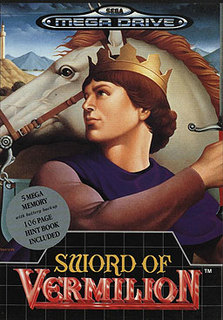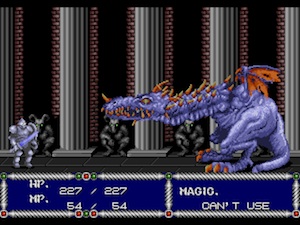
Sword of Vermilion was a very early MegaDrive RPG, released more or less at the same time as Phantasy Star II to enthusiastic reviews. What marked it out, however, was its dispensing with the traditional RPG combat system. Whereas encounters with monsters and assorted bad 'uns were usually determined via random number generation heavily modified by character (and non-player character) attribute scores, Sword took a different path. You're endowed with certain scores which, as per normal, can be upgraded via the accumulation of experience points as one advances a level. But encounter a baddy and you're whisked to a combat screen. You walk over to the enemy (or they will bounce/fly/slither/float/walk toward you) and tap button C to smack them with your sword while trying to avoid physical contact. It's quite simple. Easy to pick up and understand, but it can get button mashy as you advance through the game and you're assailed from multiple sides. Luckily, your experience level makes you tougher and gives your sword strikes more heft. So them horrible Gorgon things that enjoy swarming you are instantly dispatched once XP bulks you up.

What's this all in aid of, then? The plot is pretty standard fare. An evil King invaded your daddy's domain, you're whisked away and brought up by a trusty servant, and when you learn the truth it's up to you to avenge your kingdom and reclaim your birthright. Practically, the game is a sequence of marching across the wilderness, finding a town, entering a nearby dungeon, retrieving whatever, heading back to town and then moving to the next one over for pretty much the same. Sounds dull, doesn't it? Put like that, it is, and such was the standard RPG experience back then. Yet in its defence, there was something soothing and relaxing about it, despite the frequent appearance of random enemies. Going back and forth on pointless fetch quests, it's almost therapeutic. There are no major plot points, nothing stands out - it's just a linear path from start to finish. The only twist, if it can be called that, is when a shopkeeper mid-game steals your weapons and money and you have to start from scratch again. But that later turns out to be necessary to the plot.
As mechanics go, despite being an action RPG there isn't much that stands out. Heal up by forking out for a night at the inn. Head to churches for save points (which us where you're resurrected should things go very badly wrong). Its most peculiar feature, I suppose, is Sword is a solitary affair throughout. There aren't many 16-bit RPGs that don't task the player with the acquisition of characters of varying abilities.

Retro game-wise, is Sword of Vermilion worth playing today? It depends whether you like 16-bit RPGs, I guess. Confession time: I hadn't properly played a RPG between the mid 90s and last year's outing on Phantasy Star for the blog, so haven't had my expectations modified by your Skyrims and Dragon Ages. Because my preconceptions and gaming habits are stuck in the past, I got plenty of enjoyment out of it. But Sword probably constitutes something of a specialist interest.



No comments:
Post a Comment